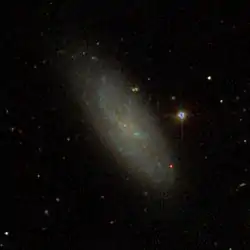NGC 4633
NGC 4633 is a spiral galaxy located about 70 million light-years away[2] in the constellation of Coma Berenices.[3] It is interacting with the nearby galaxy NGC 4634.[4][5] NGC 4633 was discovered by astronomer Edward D. Swift on April 27, 1887. It was rediscovered on November 23, 1900 by astronomer Arnold Schwassmann and was later listed as IC 3688.[6] NGC 4633 is a member of the Virgo Cluster.[7][5]
| NGC 4633 | |
|---|---|
 SDSS image of NGC 4633. | |
| Observation data (J2000 epoch) | |
| Constellation | Coma Berenices |
| Right ascension | 12h 42m 37.4s[1] |
| Declination | 14° 21′ 26″[1] |
| Redshift | 0.000971/291 km/s[1] |
| Distance | 69,154,400 ly |
| Group or cluster | Virgo Cluster |
| Apparent magnitude (V) | 13.8[1] |
| Characteristics | |
| Type | SAB(s)dm[1] |
| Size | ~45,602.76 ly (estimated) |
| Apparent size (V) | 2.29 x 0.83[1] |
| Other designations | |
| IC 3688, PGC 42699, UGC 7874, VCC 1929[1] | |
See also
References
- "NASA/IPAC Extragalactic Database". Results for NGC 4633. Retrieved 2017-09-12.
- "Your NED Search Results". ned.ipac.caltech.edu. Retrieved 2017-09-14.
- Rojas, Sebastián García. "Galaxy NGC 4633 - Galaxy in Coma Berenices Constellation · Deep Sky Objects Browser". DSO Browser. Retrieved 2017-09-14.
- information@eso.org. "Glowing gas and dark dust in a side-on spiral". www.spacetelescope.org. Retrieved 2017-09-14.
- "Detailed Object Classifications". ned.ipac.caltech.edu. Retrieved 2017-09-14.
- "New General Catalog Objects: NGC 4600 - 4649". cseligman.com. Retrieved 2017-09-03.
- "The Virgo Cluster". www.atlasoftheuniverse.com. Retrieved 2017-09-14.
External links
 Media related to NGC 4633 at Wikimedia Commons
Media related to NGC 4633 at Wikimedia Commons
- NGC 4633 on WikiSky: DSS2, SDSS, GALEX, IRAS, Hydrogen α, X-Ray, Astrophoto, Sky Map, Articles and images
This article is issued from Wikipedia. The text is licensed under Creative Commons - Attribution - Sharealike. Additional terms may apply for the media files.